外文文献翻译——参考格式
- 格式:wps
- 大小:335.71 KB
- 文档页数:18
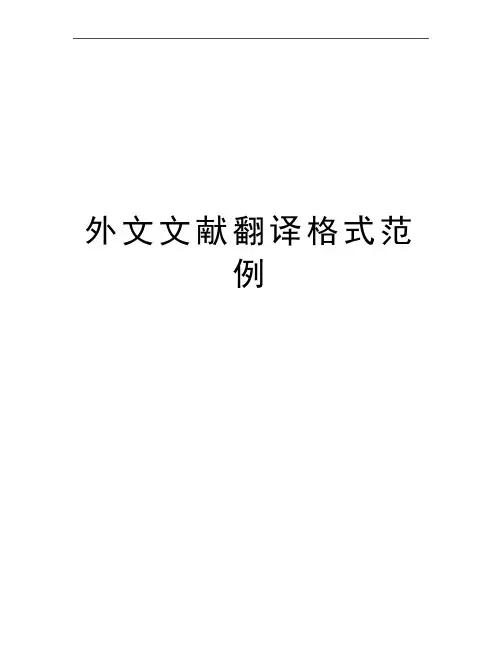
外文文献翻译格式范例本科毕业设计(外文翻译)外文参考文献译文及原文学院信息工程学院专业信息工程(电子信息工程方向)年级班别 2006级(4)班学号 3206003186学生姓名柯思怡指导教师 ______ 田妮莉 _ __2010年6月目录熟悉微软SQL Server (1)1Section A 引言 (1)2Section B 再谈数据库可伸缩性 (4)3Section C 数据库开发的特点 (7)Get Your Arms around Microsoft SQL Server (9)1Section A Introduction to SQL Server 2005 (9)2Section B Database Scalability Revisited (13)3Section C Features for Database Development (17)熟悉微软SQL Server1 Section A 引言SQL Server 2005 是微软SQL生产线上最值得期待的产品。
在经过了上百万个邮件,成百上千的规范说明,以及数十次修订后。
微软承诺SQL Server 2005 是最新的基于Windows数据库应用的数据库开发平台。
这节的内容将指出SQL Server 2005产品的一些的重要特征。
SQL Server 2005几乎覆盖OLTP及OLAP技术的所又内容。
微软公司的这个旗舰数据库产品几乎能覆盖所有的东西。
这个软件在经过五年多的制作后,成为一个与它任何一个前辈产品都完全不同的产品。
本节将介绍整个产品的大部分功能。
当人们去寻求其想要的一些功能和技术时,可以从中提取出重要的和最感新区的内容,包括SQL Server Engine 的一些蜕变的历史,以及各种各样的SQL Server 2005的版本,可伸缩性,有效性,大型数据库的维护以及商业智能等如下:●数据库引擎增强技术。
SQL Server 2005 对数据库引擎进行了许多改进,并引入了新的功能。
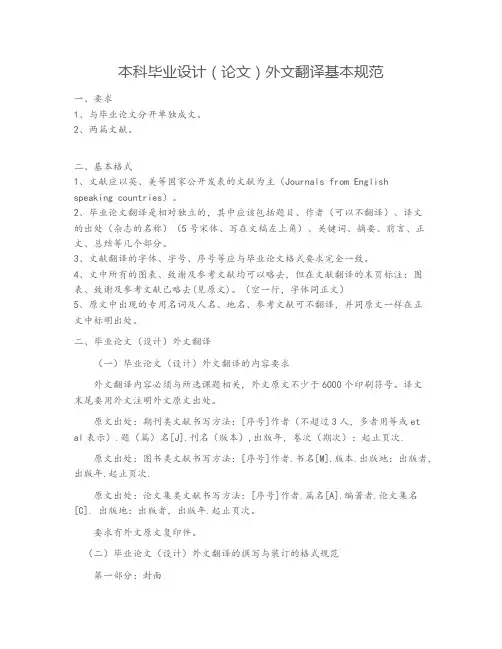
本科毕业设计(论文)外文翻译基本规范一、要求1、与毕业论文分开单独成文。
2、两篇文献。
二、基本格式1、文献应以英、美等国家公开发表的文献为主(Journals from English speaking countries)。
2、毕业论文翻译是相对独立的,其中应该包括题目、作者(可以不翻译)、译文的出处(杂志的名称)(5号宋体、写在文稿左上角)、关键词、摘要、前言、正文、总结等几个部分。
3、文献翻译的字体、字号、序号等应与毕业论文格式要求完全一致。
4、文中所有的图表、致谢及参考文献均可以略去,但在文献翻译的末页标注:图表、致谢及参考文献已略去(见原文)。
(空一行,字体同正文)5、原文中出现的专用名词及人名、地名、参考文献可不翻译,并同原文一样在正文中标明出处。
二、毕业论文(设计)外文翻译(一)毕业论文(设计)外文翻译的内容要求外文翻译内容必须与所选课题相关,外文原文不少于6000个印刷符号。
译文末尾要用外文注明外文原文出处。
原文出处:期刊类文献书写方法:[序号]作者(不超过3人,多者用等或et al表示).题(篇)名[J].刊名(版本),出版年,卷次(期次):起止页次.原文出处:图书类文献书写方法:[序号]作者.书名[M].版本.出版地:出版者,出版年.起止页次.原文出处:论文集类文献书写方法:[序号]作者.篇名[A].编著者.论文集名[C]. 出版地:出版者,出版年.起止页次。
要求有外文原文复印件。
(二)毕业论文(设计)外文翻译的撰写与装订的格式规范第一部分:封面1.封面格式:见“毕业论文(设计)外文翻译封面”。
普通A4纸打印即可。
第二部分:外文翻译主题1.标题一级标题,三号字,宋体,顶格,加粗二级标题,四号字,宋体,顶格,加粗三级标题,小四号字,宋体,顶格,加粗2.正文小四号字,宋体。
第三部分:版面要求论文开本大小:210mm×297mm(A4纸)版芯要求:左边距:25mm,右边距:25mm,上边距:30mm,下边距:25mm,页眉边距:23mm,页脚边距:18mm字符间距:标准行距:1.25倍页眉页角:页眉的奇数页书写—浙江师范大学学士学位论文外文翻译。
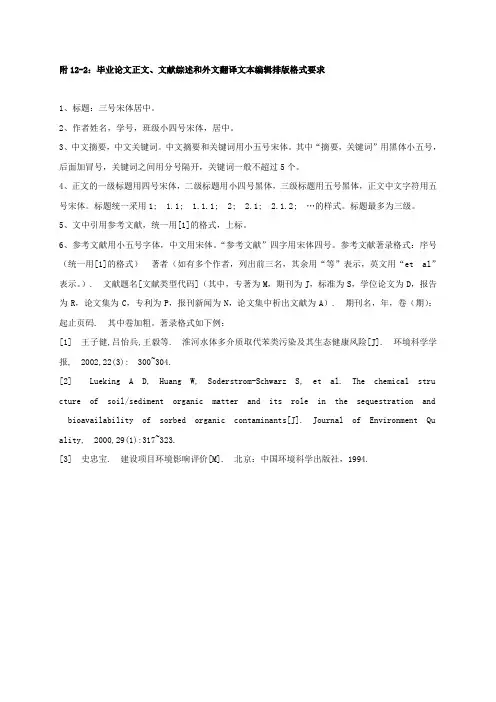
附12-2:毕业论文正文、文献综述和外文翻译文本编辑排版格式要求1、标题:三号宋体居中。
2、作者姓名,学号,班级小四号宋体,居中。
3、中文摘要,中文关键词。
中文摘要和关键词用小五号宋体。
其中“摘要,关键词”用黑体小五号,后面加冒号,关键词之间用分号隔开,关键词一般不超过5个。
4、正文的一级标题用四号宋体,二级标题用小四号黑体,三级标题用五号黑体,正文中文字符用五号宋体。
标题统一采用1; 1.1; 1.1.1; 2; 2.1; 2.1.2; …的样式。
标题最多为三级。
5、文中引用参考文献,统一用[1]的格式,上标。
6、参考文献用小五号字体,中文用宋体。
“参考文献”四字用宋体四号。
参考文献著录格式:序号(统一用[1]的格式)著者(如有多个作者,列出前三名,其余用“等”表示,英文用“et al”表示。
). 文献题名[文献类型代码](其中,专著为M,期刊为J,标准为S,学位论文为D,报告为R,论文集为C,专利为P,报刊新闻为N,论文集中析出文献为A). 期刊名,年,卷(期):起止页码. 其中卷加粗。
著录格式如下例:[1] 王子健,吕怡兵,王毅等. 淮河水体多介质取代苯类污染及其生态健康风险[J]. 环境科学学报, 2002,22(3): 300~304.[2] Lueking A D, Huang W, Soderstrom-Schwarz S, et al. The chemical structure of soil /sediment organic matter and its role in the sequestration and bioavailability of sorb ed organic contaminants[J]. Journal of Environment Quality, 2000,29(1):317~323. [3] 史忠宝. 建设项目环境影响评价[M]. 北京:中国环境科学出版社,1994.。
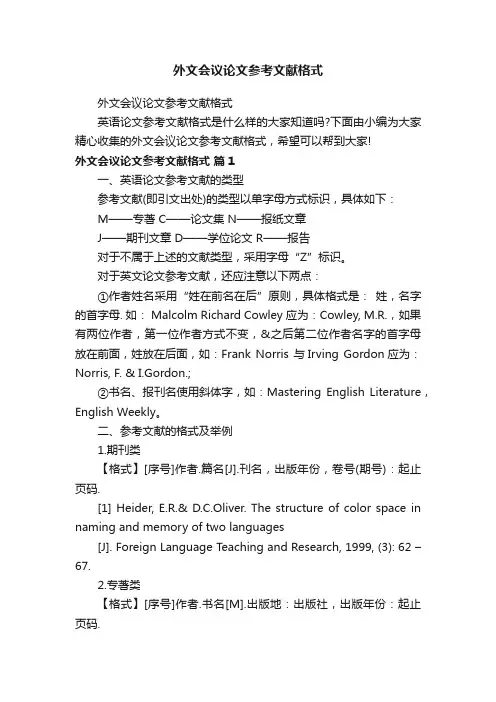
外文会议论文参考文献格式外文会议论文参考文献格式英语论文参考文献格式是什么样的大家知道吗?下面由小编为大家精心收集的外文会议论文参考文献格式,希望可以帮到大家!外文会议论文参考文献格式篇1一、英语论文参考文献的类型参考文献(即引文出处)的类型以单字母方式标识,具体如下:M——专著 C——论文集 N——报纸文章J——期刊文章 D——学位论文 R——报告对于不属于上述的文献类型,采用字母“Z”标识。
对于英文论文参考文献,还应注意以下两点:①作者姓名采用“姓在前名在后”原则,具体格式是:姓,名字的首字母. 如: Malcolm Richard Cowley 应为:Cowley, M.R.,如果有两位作者,第一位作者方式不变,&之后第二位作者名字的首字母放在前面,姓放在后面,如:Frank Norris 与Irving Gordon应为:Norris, F. & I.Gordon.;②书名、报刊名使用斜体字,如:Mastering English Literature,English Weekly。
二、参考文献的格式及举例1.期刊类【格式】[序号]作者.篇名[J].刊名,出版年份,卷号(期号):起止页码.[1] Heider, E.R.& D.C.Oliver. The structure of color space in naming and memory of two languages[J]. Foreign Language Teaching and Research, 1999, (3): 62 –67.2.专著类【格式】[序号]作者.书名[M].出版地:出版社,出版年份:起止页码.[1] Gill, R. Mastering English Literature [M]. London: Macmillan, 1985: 42-45.3.报纸类【格式】[序号]作者.篇名[N].报纸名,出版日期(版次).4.论文集【格式】[序号]作者.篇名[C].出版地:出版者,出版年份:起始页码.[1] Spivak,G. “Can the Subaltern Speak?”[A]. In C.Nelson & L. Grossberg(eds.). Victory in Limbo: Imigism [C]. Urbana: University of Illinois Press, 1988, pp.271-313.[2] Almarza, G.G. Student foreign language teacher’s knowledge growth [A]. In D.Freeman and J.C.Richards (eds.). Teacher Learning in Language T eaching [C]. New York: Cambridge University Press. 1996. pp.50-78.5.学位论文【格式】[序号]作者.篇名[D].出版地:保存者,出版年份:起始页码.6.研究报告【格式】[序号]作者.篇名[R].出版地:出版者,出版年份:起始页码.7.条例【格式】[序号]颁布单位.条例名称.发布日期8.译著【格式】[序号]原著作者. 书名[M].译者,译.出版地:出版社,出版年份:起止页码.三、注释注释是对论文正文中某一特定内容的.进一步解释或补充说明。
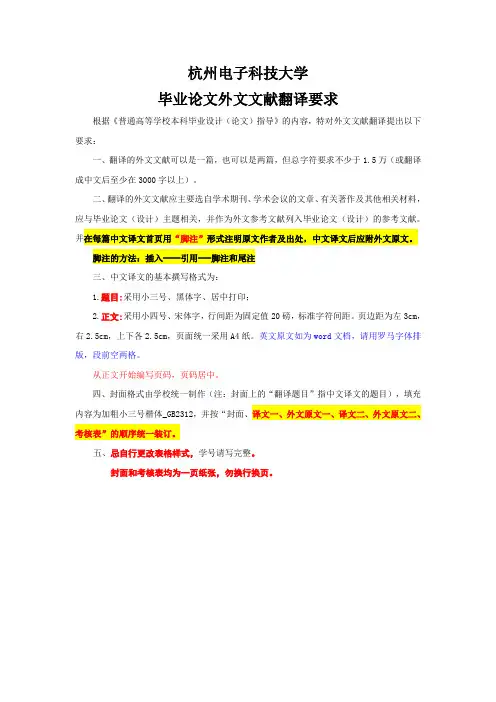
杭州电子科技大学毕业论文外文文献翻译要求根据《普通高等学校本科毕业设计(论文)指导》的内容,特对外文文献翻译提出以下要求:一、翻译的外文文献可以是一篇,也可以是两篇,但总字符要求不少于1.5万(或翻译成中文后至少在3000字以上)。
二、翻译的外文文献应主要选自学术期刊、学术会议的文章、有关著作及其他相关材料,应与毕业论文(设计)主题相关,并作为外文参考文献列入毕业论文(设计)的参考文献。
并在每篇中文译文首页用“脚注”形式注明原文作者及出处,中文译文后应附外文原文。
脚注的方法:插入----引用---脚注和尾注三、中文译文的基本撰写格式为:1.题目:采用小三号、黑体字、居中打印;2.正文:采用小四号、宋体字,行间距为固定值20磅,标准字符间距。
页边距为左3cm,右2.5cm,上下各2.5cm,页面统一采用A4纸。
英文原文如为word文档,请用罗马字体排版,段前空两格。
从正文开始编写页码,页码居中。
四、封面格式由学校统一制作(注:封面上的“翻译题目”指中文译文的题目),填充内容为加粗小三号楷体_GB2312,并按“封面、译文一、外文原文一、译文二、外文原文二、考核表”的顺序统一装订。
五、忌自行更改表格样式,学号请写完整。
封面和考核表均为一页纸张,勿换行换页。
毕业论文外文文献翻译毕业设计(论文)题目Xxx翻译(1)题目指翻译后的中文译文的题目翻译(2)题目指翻译后的中文译文的题目学院会计学院(以本模板为准)专业会计学(以本模板为准)姓名XXXXXX(以本模板为准)班级XX020811(以本模板为准)学号XX023101(以本模板为准)指导教师XXXXXX(以本模板为准)外文翻译考核表。
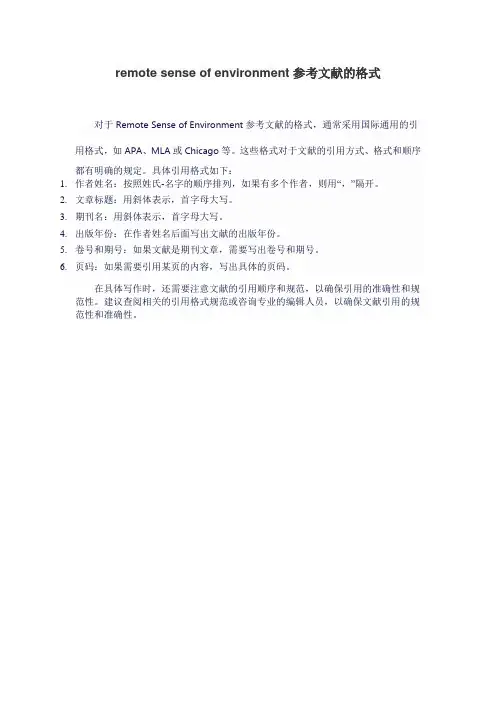
remote sense of environment参考文献的格式
对于Remote Sense of Environment参考文献的格式,通常采用国际通用的引用格式,如APA、MLA或Chicago等。
这些格式对于文献的引用方式、格式和顺序
都有明确的规定。
具体引用格式如下:
1.作者姓名:按照姓氏-名字的顺序排列,如果有多个作者,则用“,”隔开。
2.文章标题:用斜体表示,首字母大写。
3.期刊名:用斜体表示,首字母大写。
4.出版年份:在作者姓名后面写出文献的出版年份。
5.卷号和期号:如果文献是期刊文章,需要写出卷号和期号。
6.页码:如果需要引用某页的内容,写出具体的页码。
在具体写作时,还需要注意文献的引用顺序和规范,以确保引用的准确性和规范性。
建议查阅相关的引用格式规范或咨询专业的编辑人员,以确保文献引用的规范性和准确性。
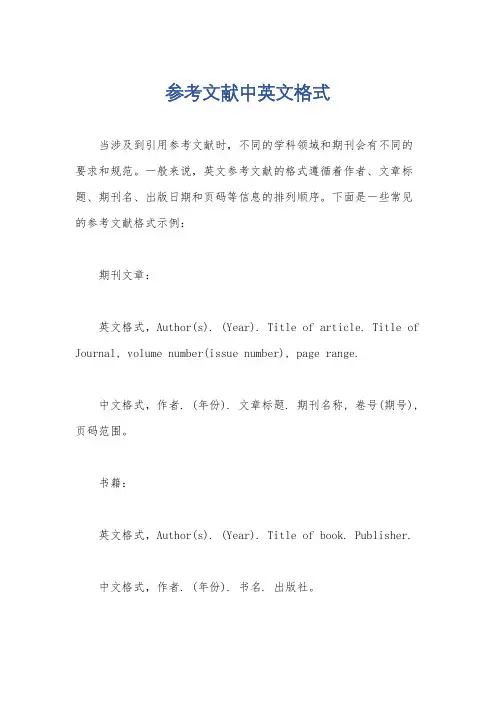
参考文献中英文格式
当涉及到引用参考文献时,不同的学科领域和期刊会有不同的要求和规范。
一般来说,英文参考文献的格式遵循着作者、文章标题、期刊名、出版日期和页码等信息的排列顺序。
下面是一些常见的参考文献格式示例:
期刊文章:
英文格式,Author(s). (Year). Title of article. Title of Journal, volume number(issue number), page range.
中文格式,作者. (年份). 文章标题. 期刊名称, 卷号(期号), 页码范围。
书籍:
英文格式,Author(s). (Year). Title of book. Publisher.
中文格式,作者. (年份). 书名. 出版社。
网页:
英文格式,Author(s). (Year). Title of webpage. Site name. URL (Accessed date).
中文格式,作者. (年份). 网页标题. 网站名称. 网址 (访问日期)。
这只是一些常见的引用格式示例,具体的要求可能会因期刊或学术机构的要求而有所不同。
在撰写学术论文或提交文章时,最好参考目标期刊的官方引用格式指南,以确保引用格式符合要求。
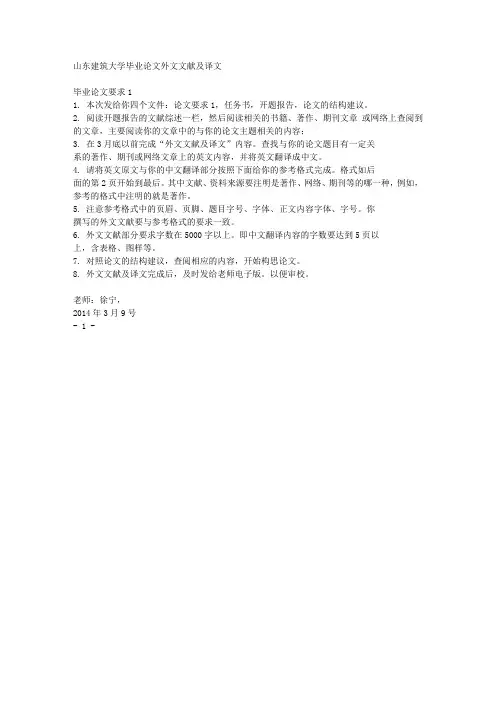
山东建筑大学毕业论文外文文献及译文
毕业论文要求1
1. 本次发给你四个文件:论文要求1,任务书,开题报告,论文的结构建议。
2. 阅读开题报告的文献综述一栏,然后阅读相关的书籍、著作、期刊文章或网络上查阅到的文章,主要阅读你的文章中的与你的论文主题相关的内容;
3. 在3月底以前完成“外文文献及译文”内容。
查找与你的论文题目有一定关
系的著作、期刊或网络文章上的英文内容,并将英文翻译成中文。
4. 请将英文原文与你的中文翻译部分按照下面给你的参考格式完成。
格式如后
面的第2页开始到最后。
其中文献、资料来源要注明是著作、网络、期刊等的哪一种,例如,参考的格式中注明的就是著作。
5. 注意参考格式中的页眉、页脚、题目字号、字体、正文内容字体、字号。
你
撰写的外文文献要与参考格式的要求一致。
6. 外文文献部分要求字数在5000字以上。
即中文翻译内容的字数要达到5页以
上,含表格、图样等。
7. 对照论文的结构建议,查阅相应的内容,开始构思论文。
8. 外文文献及译文完成后,及时发给老师电子版。
以便审校。
老师:徐宁,
2014年3月9号
- 1 -。
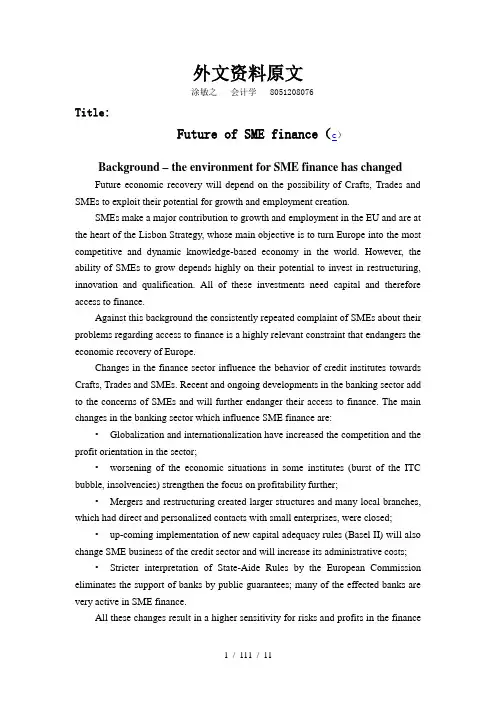
外文资料原文涂敏之会计学 8051208076Title:Future of SME finance(c)Background – the environment for SME finance has changedFuture economic recovery will depend on the possibility of Crafts, Trades and SMEs to exploit their potential for growth and employment creation.SMEs make a major contribution to growth and employment in the EU and are at the heart of the Lisbon Strategy, whose main objective is to turn Europe into the most competitive and dynamic knowledge-based economy in the world. However, the ability of SMEs to grow depends highly on their potential to invest in restructuring, innovation and qualification. All of these investments need capital and therefore access to finance.Against this background the consistently repeated complaint of SMEs about their problems regarding access to finance is a highly relevant constraint that endangers the economic recovery of Europe.Changes in the finance sector influence the behavior of credit institutes towards Crafts, Trades and SMEs. Recent and ongoing developments in the banking sector add to the concerns of SMEs and will further endanger their access to finance. The main changes in the banking sector which influence SME finance are:•Globalization and internationalization have increased the competition and the profit orientation in the sector;•worsening of the economic situations in some institutes (burst of the ITC bubble, insolvencies) strengthen the focus on profitability further;•Mergers and restructuring created larger structures and many local branches, which had direct and personalized contacts with small enterprises, were closed;•up-coming implementation of new capital adequacy rules (Basel II) will also change SME business of the credit sector and will increase its administrative costs;•Stricter interpretation of State-Aide Rules by the European Commission eliminates the support of banks by public guarantees; many of the effected banks are very active in SME finance.All these changes result in a higher sensitivity for risks and profits in the financesector.The changes in the finance sector affect the accessibility of SMEs to finance.Higher risk awareness in the credit sector, a stronger focus on profitability and the ongoing restructuring in the finance sector change the framework for SME finance and influence the accessibility of SMEs to finance. The most important changes are: •In order to make the higher risk awareness operational, the credit sector introduces new rating systems and instruments for credit scoring;•Risk assessment of SMEs by banks will force the enterprises to present more and better quality information on their businesses;•Banks will try to pass through their additional costs for implementing and running the new capital regulations (Basel II) to their business clients;•due to the increase of competition on interest rates, the bank sector demands more and higher fees for its services (administration of accounts, payments systems, etc.), which are not only additional costs for SMEs but also limit their liquidity;•Small enterprises will lose their personal relationship with decision-makers in local branches –the credit application process will become more formal and anonymous and will probably lose longer;•the credit sector will lose more and more i ts “public function” to provide access to finance for a wide range of economic actors, which it has in a number of countries, in order to support and facilitate economic growth; the profitability of lending becomes the main focus of private credit institutions.All of these developments will make access to finance for SMEs even more difficult and / or will increase the cost of external finance. Business start-ups and SMEs, which want to enter new markets, may especially suffer from shortages regarding finance. A European Code of Conduct between Banks and SMEs would have allowed at least more transparency in the relations between Banks and SMEs and UEAPME regrets that the bank sector was not able to agree on such a commitment.Towards an encompassing policy approach to improve the access of Crafts, Trades and SMEs to financeAll analyses show that credits and loans will stay the main source of finance for the SME sector in Europe. Access to finance was always a main concern for SMEs, but the recent developments in the finance sector worsen the situation even more.Shortage of finance is already a relevant factor, which hinders economic recovery in Europe. Many SMEs are not able to finance their needs for investment.Therefore, UEAPME expects the new European Commission and the new European Parliament to strengthen their efforts to improve the framework conditions for SME finance. Europe’s Crafts, Trades and SMEs ask for an encompassing policy approach, which includes not only the conditions for SMEs’ access to l ending, but will also strengthen their capacity for internal finance and their access to external risk capital.From UEAPME’s point of view such an encompassing approach should be based on three guiding principles:•Risk-sharing between private investors, financial institutes, SMEs and public sector;•Increase of transparency of SMEs towards their external investors and lenders;•improving the regulatory environment for SME finance.Based on these principles and against the background of the changing environment for SME finance, UEAPME proposes policy measures in the following areas:1. New Capital Requirement Directive: SME friendly implementation of Basel IIDue to intensive lobbying activities, UEAPME, together with other Business Associations in Europe, has achieved some improvements in favour of SMEs regarding the new Basel Agreement on regulatory capital (Basel II). The final agreement from the Basel Committee contains a much more realistic approach toward the real risk situation of SME lending for the finance market and will allow the necessary room for adaptations, which respect the different regional traditions and institutional structures.However, the new regulatory system will influence the relations between Banks and SMEs and it will depend very much on the way it will be implemented into European law, whether Basel II becomes burdensome for SMEs and if it will reduce access to finance for them.The new Capital Accord form the Basel Committee gives the financial market authorities and herewith the European Institutions, a lot of flexibility. In about 70 areas they have room to adapt the Accord to their specific needs when implementing itinto EU law. Some of them will have important effects on the costs and the accessibility of finance for SMEs.UEAPME expects therefore from the new European Commission and the new European Parliament:•The implementation of the new Capital Requirement Directive will be costly for the Finance Sector (up to 30 Billion Euro till 2006) and its clients will have to pay for it. Therefore, the implementation – especially for smaller banks, which are often very active in SME finance –has to be carried out with as little administrative burdensome as possible (reporting obligations, statistics, etc.).•The European Regulators must recognize traditional instruments for collaterals (guarantees, etc.) as far as possible.•The European Commission and later the Member States should take over the recommendations from the European Parliament with regard to granularity, access to retail portfolio, maturity, partial use, adaptation of thresholds, etc., which will ease the burden on SME finance.2. SMEs need transparent rating proceduresDue to higher risk awareness of the finance sector and the needs of Basel II, many SMEs will be confronted for the first time with internal rating procedures or credit scoring systems by their banks. The bank will require more and better quality information from their clients and will assess them in a new way. Both up-coming developments are already causing increasing uncertainty amongst SMEs.In order to reduce this uncertainty and to allow SMEs to understand the principles of the new risk assessment, UEAPME demands transparent rating procedures –rating procedures may not become a “Black Box” for SMEs: •The bank should communicate the relevant criteria affecting the rating of SMEs.•The bank should inform SMEs about its assessment in order to allow SMEs to improve.The negotiations on a European Code of Conduct between Banks and SMEs , which would have included a self-commitment for transparent rating procedures by Banks, failed. Therefore, UEAPME expects from the new European Commission and the new European Parliament support for:•binding rules in the framework of the new Capital Adequacy Directive,which ensure the transparency of rating procedures and credit scoring systems for SMEs;•Elaboration of national Codes of Conduct in order to improve the relations between Banks and SMEs and to support the adaptation of SMEs to the new financial environment.3. SMEs need an extension of credit guarantee systems with a special focus on Micro-LendingBusiness start-ups, the transfer of businesses and innovative fast growth SMEs also depended in the past very often on public support to get access to finance. Increasing risk awareness by banks and the stricter interpretation of State Aid Rules will further increase the need for public support.Already now, there are credit guarantee schemes in many countries on the limit of their capacity and too many investment projects cannot be realized by SMEs.Experiences show that Public money, spent for supporting credit guarantees systems, is a very efficient instrument and has a much higher multiplying effect than other instruments. One Euro form the European Investment Funds can stimulate 30 Euro investments in SMEs (for venture capital funds the relation is only 1:2).Therefore, UEAPME expects the new European Commission and the new European Parliament to support:•The extension of funds for national credit guarantees schemes in the framework of the new Multi-Annual Programmed for Enterprises;•The development of new instruments for securitizations of SME portfolios;•The recognition of existing and well functioning credit guarantees schemes as collateral;•More flexibility within the European Instruments, because of national differences in the situation of SME finance;•The development of credit guarantees schemes in the new Member States;•The development of an SBIC-like scheme in the Member States to close the equity gap (0.2 – 2.5 Mio Euro, according to the expert meeting on PACE on April 27 in Luxemburg).•the development of a financial support scheme to encourage the internalizations of SMEs (currently there is no scheme available at EU level: termination of JOP, fading out of JEV).4. SMEs need company and income taxation systems, whichstrengthen their capacity for self-financingMany EU Member States have company and income taxation systems with negative incentives to build-up capital within the company by re-investing their profits. This is especially true for companies, which have to pay income taxes. Already in the past tax-regimes was one of the reasons for the higher dependence of Europe’s SMEs on bank lending. In future, the result of rating w ill also depend on the amount of capital in the company; the high dependence on lending will influence the access to lending. This is a vicious cycle, which has to be broken.Even though company and income taxation falls under the competence of Member States, UEAPME asks the new European Commission and the new European Parliament to publicly support tax-reforms, which will strengthen the capacity of Crafts, Trades and SME for self-financing. Thereby, a special focus on non-corporate companies is needed.5. Risk Capital – equity financingExternal equity financing does not have a real tradition in the SME sector. On the one hand, small enterprises and family business in general have traditionally not been very open towards external equity financing and are not used to informing transparently about their business.On the other hand, many investors of venture capital and similar forms of equity finance are very reluctant regarding investing their funds in smaller companies, which is more costly than investing bigger amounts in larger companies. Furthermore it is much more difficult to set out of such investments in smaller companies.Even though equity financing will never become the main source of financing for SMEs, it is an important instrument for highly innovative start-ups and fast growing companies and it has therefore to be further developed. UEAPME sees three pillars for such an approach where policy support is needed:Availability of venture capital•The Member States should review their taxation systems in order to create incentives to invest private money in all forms of venture capital.•Guarantee instruments for equity financing should be further developed.Improve the conditions for investing venture capital into SMEs•The development of secondary markets for venture capital investments in SMEs should be supported.•Accounting Standards for SMEs should be revised in order to easetransparent exchange of information between investor and owner-manager.Owner-managers must become more aware about the need for transparency towards investors•SME owners will have to realise that in future access to external finance (venture capital or lending) will depend much more on a transparent and open exchange of information about the situation and the perspectives of their companies.•In order to fulfil the new needs for transparency, SMEs will have to use new information instruments (business plans, financial reporting, etc.) and new management instruments (risk-management, financial management, etc.).外文资料翻译涂敏之会计学 8051208076题目:未来的中小企业融资背景:中小企业融资已经改变未来的经济复苏将取决于能否工艺品,贸易和中小企业利用其潜在的增长和创造就业。

本科毕业设计(论文)外文翻译基本规范一、要求1、与毕业论文分开单独成文。
2、两篇文献。
二、基本格式1、文献应以英、美等国家公开发表的文献为主(Journals from English speaking countries)。
2、毕业论文翻译是相对独立的,其中应该包括题目、作者(可以不翻译)、译文的出处(杂志的名称)(5号宋体、写在文稿左上角)、关键词、摘要、前言、正文、总结等几个部分。
3、文献翻译的字体、字号、序号等应与毕业论文格式要求完全一致。
4、文中所有的图表、致谢及参考文献均可以略去,但在文献翻译的末页标注:图表、致谢及参考文献已略去(见原文)。
(空一行,字体同正文)5、原文中出现的专用名词及人名、地名、参考文献可不翻译,并同原文一样在正文中标明出处。
二、毕业论文(设计)外文翻译(一)毕业论文(设计)外文翻译的内容要求外文翻译内容必须与所选课题相关,外文原文不少于6000个印刷符号。
译文末尾要用外文注明外文原文出处。
原文出处:期刊类文献书写方法:[序号]作者(不超过3人,多者用等或et al表示).题(篇)名[J].刊名(版本),出版年,卷次(期次):起止页次.原文出处:图书类文献书写方法:[序号]作者.书名[M].版本.出版地:出版者,出版年.起止页次.原文出处:论文集类文献书写方法:[序号]作者.篇名[A].编著者.论文集名[C]. 出版地:出版者,出版年.起止页次。
要求有外文原文复印件。
(二)毕业论文(设计)外文翻译的撰写与装订的格式规范第一部分:封面1.封面格式:见“毕业论文(设计)外文翻译封面”。
普通A4纸打印即可。
第二部分:外文翻译主题1.标题一级标题,三号字,宋体,顶格,加粗二级标题,四号字,宋体,顶格,加粗三级标题,小四号字,宋体,顶格,加粗2.正文小四号字,宋体。
第三部分:版面要求论文开本大小:210mm×297mm(A4纸)版芯要求:左边距:25mm,右边距:25mm,上边距:30mm,下边距:25mm,页眉边距:23mm,页脚边距:18mm字符间距:标准行距:1.25倍页眉页角:页眉的奇数页书写—浙江师范大学学士学位论文外文翻译。
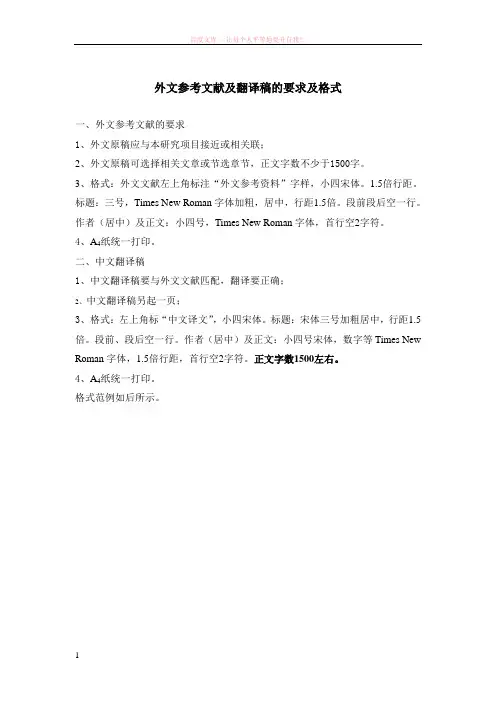
百度文库- 让每个人平等地提升自我!外文参考文献及翻译稿的要求及格式一、外文参考文献的要求1、外文原稿应与本研究项目接近或相关联;2、外文原稿可选择相关文章或节选章节,正文字数不少于1500字。
3、格式:外文文献左上角标注“外文参考资料”字样,小四宋体。
1.5倍行距。
标题:三号,Times New Roman字体加粗,居中,行距1.5倍。
段前段后空一行。
作者(居中)及正文:小四号,Times New Roman字体,首行空2字符。
4、A4纸统一打印。
二、中文翻译稿1、中文翻译稿要与外文文献匹配,翻译要正确;2、中文翻译稿另起一页;3、格式:左上角标“中文译文”,小四宋体。
标题:宋体三号加粗居中,行距1.5倍。
段前、段后空一行。
作者(居中)及正文:小四号宋体,数字等Times New Roman字体,1.5倍行距,首行空2字符。
正文字数1500左右。
4、A4纸统一打印。
格式范例如后所示。
百度文库 - 让每个人平等地提升自我!外文参考文献Implementation of internal controls of small andmedium-sized pow erStephen Ryan The enterprise internal control carries out the strength to refer to the enterprise internal control system execution ability and dynamics, it is the one whole set behavior and the technical system, is unique competitive advantage which the enterprise has; Is a series of …………………………标题:三号,Times New Roman字体加粗,居中,行距1.5倍。
外文翻译格式
外语翻译通常需要遵循一定的格式,以确保翻译内容的准确性和易读性。
以下是一个700字外文翻译的通用格式示例:
1. 标题:翻译的内容的标题,通常与原文标题保持一致,居中显示。
2. 原文:原文内容,可将原文段落编号,并保留原文格式,如段落缩进或列表。
3. 译文:相关段落的翻译内容,与原文一一对应,并保持相同的段落编号和格式。
4. 术语翻译:将翻译中使用的特定术语或固定表达进行解释和翻译,避免出现歧义。
5. 校对与审校:对翻译内容进行校对和审校,确保翻译准确无误。
6. 结论:对整个翻译内容进行总结和评价,提出自己的观点和见解。
7. 参考文献:如有需要,列出翻译过程中所参考的文献或资料。
8. 附录:如有需要,可在翻译后添加附录,补充相关资料或说明。
注意事项:
- 翻译应遵循专业的术语和语法规范,尽量保持翻译内容的准确性。
- 可根据需要调整段落的分配和序号,以符合原文和翻译内容的逻辑结构。
- 保持翻译格式的统一和美观,使用合适的字体和字号,并注意标点符号的使用。
- 翻译结束后,应进行校对和审校,以确保翻译质量的准确性和流畅性。
总之,一个700字外文翻译的格式应该清晰明了,结构合理,准确无误,并能为读者提供一个清晰且易于理解的翻译内容。
英文译著参考文献格式英文译著参考文献的格式可以根据不同的引用风格而有所不同。
以下是根据APA引用风格的标准格式示例:1. 单一作者的译著:作者姓, 作者名. (出版年). 书名 (译者名, 译). 出版地: 出版商.例如:Smith, J. (2010). The Art of Translation (Wang, L., 译). Beijing: Publishing House.2. 两位作者的译著:作者1姓, 作者1名., & 作者2姓, 作者2名. (出版年). 书名 (译者名, 译). 出版地: 出版商.例如:Johnson, M., & Anderson, P. (2015). Introduction to Translation Studies (Li, H., 译). Shanghai: University Press.3. 多位作者的译著:作者1姓, 作者1名., 作者2姓, 作者2名., & 作者3姓, 作者3名. (出版年). 书名 (译者名, 译). 出版地: 出版商.例如:Smith, J., Johnson, M., & Anderson, P. (2012). Comparative Translation Studies (Wu, Y., 译). Beijing: Publishing House.4. 编辑的译著:编者姓, 编者名. (Ed.). (出版年). 书名 (译者名, 译). 出版地: 出版商.例如:Brown, A. (Ed.). (2008). Translation and Language Teaching (Zhang, L., 译). Shanghai: University Press.需要注意的是,以上的格式是根据APA引用风格的标准来给出的示例,其他引用风格(如MLA、Chicago等)可能会有稍微的差异。
毕业论文外文文献格式毕业论文外文文献格式参考文献的引用应当实事求是、科学合理,不可以为了凑数随便引用。
毕业论文外文文献的格式是什么?毕业论文外文文献格式格式要求一、翻译的外文文献一般为1~2篇,外文字符要求不少于1.5万(或翻译成中文后至少在3000字以上)。
二、翻译的外文文献应主要选自学术期刊、学术会议的文章、有关着作及其他相关材料,应与毕业论文(设计)主题相关,并作为外文参考文献列入毕业论文(设计)的参考文献。
并在每篇中文译文首页用“脚注”形式注明原文作者及出处,中文译文后应附外文原文。
三、中文译文的基本撰写格式为题目采用小三号黑体字居中打印,正文采用宋体小四号字,行间距一般为固定值20磅,标准字符间距。
页边距为左3cm,右2.5cm,上下各2.5cm,页面统一采用A4纸。
四、封面格式由学校统一制作(注:封面上的“翻译题目”指中文译文的题目,附件1为一篇外文翻译的'封面格式,附件二为两篇外文翻译的封面格式),若有两篇外文文献,请按“封面、译文一、外文原文一、译文二、外文原文二”的顺序统一装订。
标题(20字以内,可用副标题补充说明,4号黑体加粗。
居中)(5号空一行)外文作者署名(Times New Roman5号,居中)(5号空一行)(外文翻译成中文的内容)(5号宋体)(5号空一行)外文着录(填写此项内容)(5号宋体)按照:着录/ 题名/ 出版事项顺序排列注明期刊--着者,题名,期刊名称,出版年,卷号(期号),起始页码。
书籍--着者,书名,版次(第一版不标注),出版地,出版者,出版年,起始页码。
说明:译文前面附被翻译的外文原件复印件,复印件用与论文稿纸相同大小的白纸(A4纸张)复印参考文献范例:[1] FREDERICK S,RICHARD B,ERIC M, Full body interface pressure testing as a method for performance evaluation of clinical support surfaces [Jj. Applied Ergonomics, 1998,29(6): 491-497.[2]Roy J E, Dick F S, Eus J W.Skin temperature and sleep-onset latency: Changes with age and insomnia [J]. Physiology Behavior, 2007,90(2-3): 257~266.[3]Hyunja L, Sejin P. Quantitative effects of mattress types (comfortable vs. uncomfortable) on sleep quality through poly-somnography and skin temperature[J]. International Journal of Industrial Ergonomics,2006, 36(11): 943一949.[4]Miguel L T, Rosa P J. Objective firmness, average pressureand subjective perception in mattresses for the elderly [ J].Applied Ergonomics, 2008, 39(1):123-130.[5]Ling L T,Hau M L.Effects of bedding systems selected by manual muscle testing on sleep-related respiratory disturbances[J] .Applied Ergonomics, 2008,39(2):261-270.[6]Haex B. Back and bed: Ergonomic Aspects of Sleeping CRC Press, Boca Raton,FL, 2004.[7]Hildebrandt V H, Back pain in the working population: prevalence rates in Dutch trades and professions [J]. Ergonomics, 1995, 38.[8]Lee H, Park S. Quantitative effects of mattress type on sleep quality through polysomnography and skin temperature [J]. Industrial Ergonomics, 2006, 36:934-949.[9]Jacobson B H,Wallace T J, Smith D B, et al. Grouped comparisons of sleep quality for new and personal bedding systems [J]. Applied Ergonomics, 2007,39.[10]Bader.GQ Engdal S. The influence of bed firmness on sleep quality [J]. Applied Ergonomics, 2000,31.[11]BUCKXEP, FERN ANDES A. Mattress evaluation-assessment of a cont act pres sure,comfort and discomfort [J]. Applied Ergonomics, 1998,29(1)。
杭州电子科技大学信息工程学院毕业论文外文文献翻译要求根据《普通高等学校本科毕业设计(论文)指导》的内容,特对外文文献翻译提出以下要求:一、翻译的外文文献可以是一篇,也可以是两篇,但总字符要求不少于1.5万(或翻译成中文后至少在3000字以上)。
二、翻译的外文文献应主要选自学术期刊、学术会议的文章、有关著作及其他相关材料,应与毕业论文(设计)主题相关,并作为外文参考文献列入毕业论文(设计)的参考文献。
并在每篇中文译文首页用“脚注”形式注明原文作者及出处,中文译文后应附外文原文。
三、中文译文的基本撰写格式为:1.题目:采用小三号、黑体字、居中打印;2.正文:采用小四号、宋体字,行间距一般为固定值20磅,标准字符间距。
页边距为左3cm,右2.5cm,上下各2.5cm,页面统一采用A4纸。
四、封面格式由学校统一制作(注:封面上的“翻译题目”指中文译文的题目),并按“封面、译文一、外文原文一、译文二、外文原文二、考核表”的顺序统一装订。
五、忌自行更改表格样式。
毕业论文外文文献翻译毕业设计(论文)题目Xxx翻译(1)题目指翻译后的中文译文的题目翻译(2)题目指翻译后的中文译文的题目系会计系以本模板为准)专业XXXXXX(以本模板为准)姓名XXXXXX(以本模板为准)班级XXXXXX(以本模板为准)学号XXXXXX(以本模板为准)指导教师XXXXXX(以本模板为准)正文3杭州电子科技大学信息工程学院本科毕业论文文献综述的写作要求为了促使学生熟悉更多的专业文献资料,进一步强化学生搜集文献资料的能力,提高对文献资料的归纳、分析、综合运用能力及独立开展科研活动的能力,现对本科学生的毕业设计(论文)提出文献综述的写作要求,具体要求如下:一、文献综述的概念文献综述是针对某一研究领域或专题搜集大量文献资料的基础上,就国内外在该领域或专题的主要研究成果、最新进展、研究动态、前沿问题等进行综合分析而写成的、能比较全面地反映相关领域或专题历史背景、前人工作、争论焦点、研究现状和发展前景等内容的综述性文章。
外文文献翻译(附原文)外文译文一:产业集群的竞争优势——以中国大连软件工业园为例Weilin Zhao,Chihiro Watanabe,Charla-Griffy-Brown[J]. Marketing Science,2009(2):123-125.摘要:本文本着为促进工业的发展的初衷探讨了中国软件公园的竞争优势。
产业集群深植于当地的制度系统,因此拥有特殊的竞争优势。
根据波特的“钻石”模型、SWOT模型的测试结果对中国大连软件园的案例进行了定性的分析。
产业集群是包括一系列在指定地理上集聚的公司,它扎根于当地政府、行业和学术的当地制度系统,以此获得大量的资源,从而获得产业经济发展的竞争优势。
为了成功驾驭中国经济范式从批量生产到开发新产品的转换,持续加强产业集群的竞争优势,促进工业和区域的经济发展是非常有必要的。
关键词:竞争优势;产业集群;当地制度系统;大连软件工业园;中国;科技园区;创新;区域发展产业集群产业集群是波特[1]也推而广之的一个经济发展的前沿概念。
作为一个在全球经济战略公认的专家,他指出了产业集群在促进区域经济发展中的作用。
他写道:集群的概念,“或出现在特定的地理位置与产业相关联的公司、供应商和机构,已成为了公司和政府思考和评估当地竞争优势和制定公共决策的一种新的要素。
但是,他至今也没有对产业集群做出准确的定义。
最近根据德瑞克、泰克拉[2]和李维[3]检查的关于产业集群和识别为“地理浓度的行业优势的文献取得了进展”。
“地理集中”定义了产业集群的一个关键而鲜明的基本性质。
产业由地区上特定的众多公司集聚而成,他们通常有共同市场、,有着共同的供应商,交易对象,教育机构和其它像知识及信息一样无形的东西,同样地,他们也面临相似的机会和威胁。
在全球产业集群有许多种发展模式。
比如美国加州的硅谷和马萨诸塞州的128鲁特都是知名的产业集群。
前者以微电子、生物技术、和风险资本市场而闻名,而后者则是以软件、计算机和通讯硬件享誉天下[4]。
20外⽂⽂献翻译原⽂及译⽂参考样式华北电⼒⼤学科技学院毕业设计(论⽂)附件外⽂⽂献翻译学号: 0819******** 姓名:宗鹏程所在系别:机械⼯程及⾃动化专业班级:机械08K1指导教师:张超原⽂标题:Development of a High-PerformanceMagnetic Gear年⽉⽇⾼性能磁齿轮的发展1摘要:本⽂提出了⼀个⾼性能永磁齿轮的计算和测量结果。
上述分析的永磁齿轮有5.5的传动⽐,并能够提供27 Nm的⼒矩。
分析表明,由于它的弹簧扭转常数很⼩,因此需要特别重视安装了这种⾼性能永磁齿轮的系统。
上述分析的齿轮也已经被应⽤在实际中,以验证、预测其效率。
经测量,由于较⼤端齿轮传动引起的磁⼒齿轮的扭矩只有16 Nm。
⼀项关于磁齿轮效率损失的系统研究也展⽰了为什么实际⼯作效率只有81%。
⼀⼤部分磁损耗起源于轴承,因为机械故障的存在,此轴承的备⽤轴承在此时是必要的。
如果没有源于轴的少量磁泄漏,我们估计能得到⾼达96%的效率。
与传统的机械齿轮的⽐较表明,磁性齿轮具有更好的效率和单位体积较⼤扭矩。
最后,可以得出结论,本⽂的研究结果可能有助于促进传统机械齿轮向磁性齿轮发展。
关键词:有限元分析(FEA)、变速箱,⾼转矩密度,磁性齿轮。
⼀、导⾔由于永久磁铁能产⽣磁通和磁⼒,虽然⼏个世纪过去了,许多⼈仍然着迷于永久磁铁。
,在过去20年的复兴阶段,正是这些优点已经使得永久磁铁在很多实际中⼴泛的应⽤,包括在起重机,扬声器,接头领域,尤其是在永久磁铁电机⽅⾯。
其中对永磁铁的复兴最常见于效率和转矩密度由于永磁铁的应⽤显著提⾼的⼩型机器的领域。
在永久磁铁没有获取⾼度重视的⼀个领域是传动装置的领域,也就是说,磁⼒联轴器不被⼴泛⽤于传动装置。
磁性联轴器基本上可以被视为以传动⽐为1:1磁⼒齿轮。
相⽐标准电⽓机器有约10kN m/m的扭矩,装有⾼能量永久磁铁的磁耦有⾮常⾼的单位体积密度的扭矩,变化范围⼤约300–400 kN 。